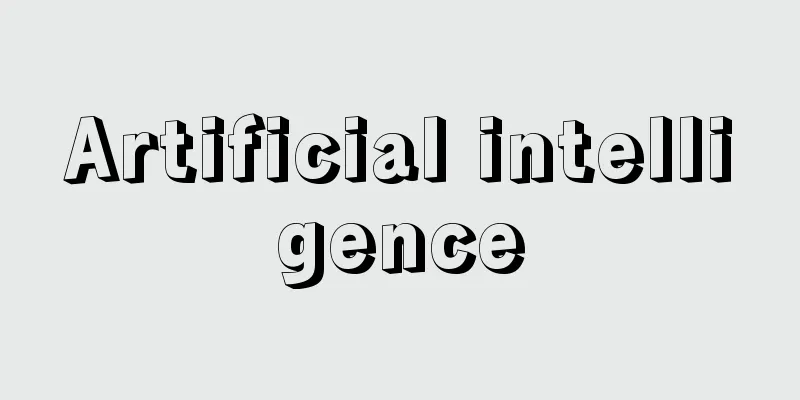Artificial intelligence

OverviewArtificial intelligence is a field of computer science that studies intelligence using the concept of computation and the tool of computers. In simple terms, it is a field that studies how to mechanically perform intellectual actions (recognition, inference, language use, creation, etc.) that were previously only possible for humans, using the procedures (algorithms) and data (prior information and knowledge). It is often abbreviated as AI. The name of the research field, artificial intelligence, was coined at a research conference (Dartmouth Conference) held at Dartmouth College in the United States in the summer of 1956. The conference was attended by people who would later play leading roles in artificial intelligence research, including John McCarthy (1927-2011), Marvin Minsky (1927-2016), Allen Newell (1927-1992), and Herbert Simon (1916-2001), and discussed the theme of simulating human intellectual functions using computers. There is still no satisfactory answer to the question, "What is intelligence?" One of the goals of artificial intelligence is to realize a computer program that can perform a specific task that is thought to require intelligence to perform (for example, playing Go) as well as a human or better than a human. Another goal is to get closer to the answer to the question, "What is intelligence?" through the realization of such a program. To achieve this goal, artificial intelligence intersects with other research fields related to intelligence, particularly philosophy, psychology, cognitive science, brain science, and linguistics. [Masafumi Sato June 19, 2018] History of Artificial Intelligence (Part 1)Research into artificial intelligence began before the term was even coined. Von Neumann formulated the minimax algorithm in 1944. The Turing test, a famous test for measuring intelligence, was proposed in 1950. Around this time, Shannon also conducted research into chess. Warren McCulloch (1899-1969) and Walter Pitts (1923-1969), who could be considered the fathers of neural networks, developed their neuron model in 1943. Research into machine translation also began in the early 1950s. Artificial intelligence research in the 1960s can be considered the era of search. Targeting mainly "closed world" problems such as games, the problem was strictly defined in terms of the problem's phase (state) and phase-changing operations (operators), and the problem was treated as a search problem in which a path from the initial state to the final state (solution) was to be found. In general, the number of states that can be reached from the initial state increases exponentially with the number of times an operator is applied. One way to avoid this is to introduce heuristics, and the A * (A*ster) algorithm, which utilizes heuristics, is one of the major research results of this period. ELIZA, a famous program that can converse with humans in English, was developed in 1966 by Joseph Weizenbaum (1923-2008). This program had built-in rules for generating responses from human speech (input), and could behave as if it understood what humans were saying. The Japanese version of the program, known as the "Artificial Brainless," is a descendant of ELIZA. The mainstream method of realizing systems during this period was rule-based symbolic processing. The programming language Lisp, developed by McCarthy, was often used to build systems. Meanwhile, neural networks, a representative example of non-symbolic processing, were proposed as perceptrons around 1958 by Frank Rosenblatt (1928-1971), but the limits of their processing power were demonstrated in 1969, and research into them temporarily waned. [Masafumi Sato June 19, 2018] History of Artificial Intelligence (2nd Period)If the first period up to the 1960s was the search (procedure) period, the second period from the 1970s to the 1980s was the knowledge period. During this period, attempts were made to apply artificial intelligence technology to real-world problems, and expert proxy systems called expert systems were developed. Representative examples include DENDRAL, which estimates the structure of organic compounds, MYCIN, which supports the diagnosis of bacteria in blood, and R1, which supports the configuration of computer systems. In order to accomplish these tasks, specialized knowledge about the task is essential. In other words, tasks cannot be accomplished by methods alone (procedures), and specialized knowledge must be utilized. In this context, the core research topics were how to give knowledge to computers (knowledge acquisition), how to represent and store it on a computer (knowledge representation), and how to utilize it (inference methods), and this came to be called knowledge engineering. In terms of knowledge representation, methods were proposed for describing related chunks of knowledge, such as frames and scripts, while methods such as the blackboard model, which allows independent groups of rules to work in coordination, were devised. In addition to the previous inference based on if-then rules, a variety of inference methods were also devised, such as case-based reasoning oriented towards analogy and Bayesian networks that deal with uncertainty. The problem of knowledge acquisition remained unsolved until the end, and was called the knowledge acquisition bottleneck. This was because there is some knowledge that humans cannot make conscious of or put into words (symbolize), and so-called common sense is necessary to accomplish many tasks. Research into machine learning gradually expanded from this period, and one of the reasons for this is due to the above background. A famous example of natural language processing from this period is SHRDLU by Terry Winograd (1946- ). This system solved problems using syntactic analysis, semantic analysis, and inference for manipulating the world of building blocks, demonstrating the importance of meaning and external knowledge in natural language understanding. Roger Schank's (1946- ) conceptual dependency theory and his research into story understanding using it are also famous as research oriented toward meaning understanding. In non-symbolic processing, multi-layer neural networks and their learning algorithm, backpropagation, became widely known as connectionist models, and neural networks made a comeback. Research inspired by life and evolution, such as artificial life and genetic algorithms, also appeared. In Japan, the "Fifth Generation Computer" project began in 1982, developing a parallel computer for knowledge processing and a parallel logic language to run on that computer. Although the project produced many results, the parallel computers and parallel logic languages that were developed did not become widely used, and the project is generally considered a failure. After the project ended, coupled with the collapse of the bubble economy, Japanese artificial intelligence research entered a period of stagnation. Globally, this was a time when computers and networks were becoming more prevalent in society, with the spread of personal computers (Windows 95 was released in 1995) and the explosive growth of the Internet (around 1996). AI was overshadowed by these trends and did not receive much attention. The exception was Deep Blue, a chess program developed by IBM, which caused a big stir in 1997 when it defeated the world champion, Garry Kimovich Kasparov (1963-). In the field of robotics, Rodney Allen Brooks (1954-) presented a new idea called subsumption architecture. This became the roots of today's cleaning robots. [Masafumi Sato June 19, 2018] History of Artificial Intelligence (3rd Period)The Internet expanded rapidly, and since around 2000 it has become an important part of social infrastructure. Through search engines for finding web pages, Wikipedia which stores encyclopedic knowledge, and online shopping sites such as Amazon, large amounts of knowledge and data have been stored on the Internet as electronic data. In the second half of the 2000s, smartphones and social networking services appeared, creating a system in which personal data such as behavioral history could also be stored electronically. These changes in circumstances are closely related to the current boom in artificial intelligence. One of the direct factors behind the rise of the third period, which has continued since 2010, was the victory of IBM's Watson in the quiz show Jeopardy!, which beat a human champion. It was a shock to see Watson surpass a human in a quiz in which participants were asked to answer questions in English using English words. The second factor was that in 2012, a team led by Geoffrey Hinton (1947-) won an image recognition contest using deep neural network learning. The third factor was that not only car manufacturers but also IT companies such as Google and Apple have been promoting research into autonomous driving, making fully autonomous driving possible. These factors combined to raise expectations for the social application of artificial intelligence technology. In the midst of this boom, in 2016, the Go program AlphaGo completely defeated a world-class Go player, making the power of machine learning and deep learning known to the world. Smartphones are now equipped with voice interfaces, allowing us to give commands by voice, and stationary devices called smart speakers (AI speakers) are beginning to become popular. What makes the third period significantly different from the past is that cutting-edge technology is immediately reflected in familiar products and services. While machine learning technology is expected to bring about major changes in all aspects of society as a core technology of data science, there is also a vague concern that it may create things that humans cannot control. [Masafumi Sato June 19, 2018] Research fields and their characteristicsResearch into artificial intelligence is diverse. The main research subjects are methods for representing and storing information and knowledge on computers (knowledge representation), methods for utilizing them (inference methods), input/output systems (various media processing), and acquisition methods (knowledge acquisition and machine learning). In the input/output system, fields such as pattern recognition and image processing for images and videos, signal processing, speech recognition, and speech synthesis for sounds, natural language processing for words, and robotics for realizing moving bodies have emerged from artificial intelligence research and have each developed into a relatively independent research field. In recent years, machine learning in particular has been in the spotlight, and is being applied to data mining from large amounts of data, image processing, speech recognition, machine translation, and more. Due to the nature of artificial intelligence research, which seeks to solve "problems whose solutions are not yet known," the research subject is no longer a target once the solutions are mostly known. For this reason, it is inevitable that the problems that are the focus of research will change over time. For example, kana-kanji conversion and handwritten postal code recognition were major research subjects in artificial intelligence in the past, but this is no longer the case. The view that artificial intelligence is a frontier area of computer applications is largely spot on. [Masafumi Sato June 19, 2018] The current state of artificial intelligence and its challengesCurrently, there is a big gap between what experts think of artificial intelligence (research) and what most people in the world think of when they hear the word "artificial intelligence." "Artificial intelligence" as depicted in science fiction novels, movies, and manga is a computer system or robot with an independent will. On the other hand, what has been realized through artificial intelligence research and technology (for example, AlphaGo) is simply a computer program. These programs simply "calculate" according to the program code and do nothing more. However, when explaining the functions of these programs, anthropomorphic expressions such as "the system learns, infers, and judges on its own" are used, and they are depicted as if they were an independent entity with a will. This tends to exacerbate the above gap. At the core of current machine learning is a mathematical technique called optimization. This is far removed from human "learning," and computers that learn like humans have not yet been realized. Current neural networks are networks based on mathematical models of nerve cells, but are not models of the brain. These facts are not widely known, which is one of the reasons for the vague anxiety mentioned above. Even experts are not fully aware of how artificial intelligence will develop in the future. Some researchers believe that it is possible to create something similar to a human brain, but most researchers believe that such a thing will not be possible in the near future. If the day comes when artificial intelligence like that in science fiction can be realized, it will mean that the answer to the question, "What is intelligence?" has been found. [Masafumi Sato June 19, 2018] "The Story of Intelligence" by Nakajima Hideyuki (2015, Future University Hakodate Press)" ▽ "AI: The Trajectory and Future of Artificial Intelligence" edited by Takeuchi Ikuo (2016, Nikkei Science Special Edition)" ▽ "The Weasel Who Doesn't Want to Work and a Robot That Can Understand Language" by Kawazoe Ai (2017, Asahi Press)" ▽ "Encyclopedia of Artificial Intelligence" edited by the Japanese Society for Artificial Intelligence (2017, Kyoritsu Shuppan)" ▽ "Artificial Intelligence and Humans" by Nagao Makoto (Iwanami Shinsho) [References] | | | | |Source: Shogakukan Encyclopedia Nipponica About Encyclopedia Nipponica Information | Legend |
概論人工知能は、「計算(computation)」という概念と「コンピュータ(computer)」という道具を用いて「知能」を研究する計算機科学(computer science)の一分野である。誤解を恐れず平易にいいかえるならば、「これまで人間にしかできなかった知的な行為(認識、推論、言語運用、創造など)を、どのような手順(アルゴリズム)とどのようなデータ(事前情報や知識)を準備すれば、それを機械的に実行できるか」を研究する分野である。AI(エーアイ)と略称でよばれることも多い。人工知能という研究分野名は、1956年夏にアメリカのダートマス大学で開催された研究集会(ダートマス会議)で命名された。この会議には、その後の人工知能研究で指導的な役割を果たすマッカーシーJohn McCarthy(1927―2011)、ミンスキーMarvin Minsky(1927―2016)、ニューウェルAllen Newell(1927―1992)、サイモンHerbert Simon(1916―2001)らが参加し、コンピュータによる人間の知的機能のシミュレーションをテーマに議論が行われた。 「知能とは何か」に対する十分な答えは、いまだ存在しない。人工知能の目標の一つは、遂行に知能が必要と思われる特定の課題(たとえば、囲碁を打つ)を対象に、その課題を人間並みあるいは人間以上にうまく行うコンピュータ・プログラムを実現することである。もう一つの目標は、そのようなプログラムの実現を通して、「知能とは何か」の答えに迫ろうというものである。このような目標をもつため、人工知能は、知能に関連した他の研究分野、とくに、哲学、心理学、認知科学、脳科学、言語学などと交差する部分をもつ。 [佐藤理史 2018年6月19日] 人工知能の歴史(第1期)人工知能の研究は、人工知能という名が生まれる前から始まっている。フォン・ノイマンによるミニマックス法の定式化が1944年。知能をはかるテストとして有名なチューリングテストの提唱は1950年。このころには、シャノンによるチェスの研究も行われた。ニューラルネットワークの祖ともいうべき、マカロックWarren McCulloch(1899―1969)とピッツWalter Pitts(1923―1969)のニューロンのモデルは1943年。機械翻訳の研究も1950年代初期に開始されている。 1960年代の人工知能研究は、探索の時代として位置づけられる。おもに、ゲームなどの「閉じた世界」の問題を対象に、問題の局面(状態)と局面変更操作(オペレータ)によって問題を厳密に定義し、初期状態から終了状態(解)に至る経路をみつけるという探索問題としてとらえ、これを効率的に解く手法が研究された。一般に、初期状態から到達可能な状態の数は、オペレータの適用回数に対して指数関数的に増加する。これを回避する一つの方法はヒューリスティクスの導入であり、それを利用するA*(エースター)アルゴリズムは、この時期の主要な研究成果の一つである。 英語で人間と対話を行うプログラムとして有名なELIZA(イライザ)は、ワイゼンバウムJoseph Weizenbaum(1923―2008)が1966年に開発した。このプログラムの内部には、人間の発言(入力)から応答を生成するためのルールが組み込まれており、あたかも人間の発言内容を理解しているかのようにふるまうことができた。「人工無脳」といった名称でよばれる日本語版のプログラムは、ELIZAの亜流である。 この時期のシステムの実現法は、ルールに基づく記号処理が主流である。マッカーシーによって開発されたプログラミング言語Lisp(リスプ)が、システム構築によく用いられた。一方、非記号処理の代表格であるニューラルネットは、1958年ごろにローゼンブラットFrank Rosenblatt(1928―1971)によりパーセプトロンが提案されたが、1969年に処理能力の限界が示され、研究は一時、下火となった。 [佐藤理史 2018年6月19日] 人工知能の歴史(第2期)1960年代までの第1期が探索(手続き)の時代とすれば、1970年代から1980年代までの第2期は、知識の時代である。この時期は、人工知能技術を実世界の問題へ応用することが試みられ、エキスパートシステムexpert systemとよばれる専門家代行システムが開発された。有機化合物構造の推定を行うDENDRAL(デンドラル)、血液中のバクテリアの診断の支援を行うMYCIN(マイシン)、コンピュータシステムの構成支援を行うR1などがその代表格である。これらの課題を遂行するためには、その課題に関する専門知識が不可欠である。つまり、やり方(手続き)だけでは課題は遂行できず、専門知識を活用しなければならない。このような背景により、コンピュータにいかにして知識を与えるか(知識獲得)、それをどのようにコンピュータ上で表現・格納しておくか(知識表現)、そして、それをどのように活用するか(推論方式)などが中核的研究課題となり、知識工学(ナレッジエンジニアリングknowledge engineering)という名でよばれるようになった。知識表現では、フレーム、スクリプトなど、関連したひとまとまりの知識を記述する方法が提案されるとともに、黒板モデルのように独立したルール群を協調させて動作させる方法などが考案された。推論方式も、それまでのif-then型ルールによる推論以外に、類推を志向した事例ベース推論、不確実性を扱うベイジアンネットワークなど、多様な方式が考案された。知識獲得の問題は、最後まで未解決として残り、知識獲得ボトルネックとよばれた。これは、知識のなかには人間が意識化できないもの、言語化(記号化)できないものが存在することや、多くの課題遂行において、いわゆる常識が必要なことなどの理由による。機械学習の研究は、この時期から徐々に拡大していくが、その理由の一つは、このような背景による。 この時期の自然言語処理では、ウィノグラードTerry Winograd(1946― )のSHRDLU(シュードル)が有名である。このシステムは、積み木の世界の操作を対象に、構文解析、意味解析、推論による問題解決を実現し、自然言語理解における意味や外部知識の重要性を示した。シャンクRoger Schank(1946― )による概念依存関係理論とそれを用いたストーリー理解の研究も、意味理解を志向した研究として有名である。 非記号処理では、多層ニューラルネットとその学習アルゴリズムであるバックプロパゲーション(誤差逆伝播(でんぱ)法)が、コネクショニストモデルとして広く知られるようになり、ニューラルネットが復権した。また、人工生命や遺伝的アルゴリズムなど、生命や進化から着想を得た研究も現れた。 日本では、1982年(昭和57)より「第五世代コンピュータ」プロジェクトが実施され、知識処理用の並列コンピュータ、および、そのコンピュータ上で動作する並列論理型言語が開発された。このプロジェクトは多くの成果を生み出したが、開発された並列コンピュータや並列論理型言語は広く使われるようにはならなかったため、世の中の評価は失敗という形で定着している。プロジェクト終了後、バブル経済の崩壊も相まって、日本の人工知能研究は停滞期に入る。 世界的にも、この時期は、パーソナルコンピュータの普及(ウィンドウズ95が1995年に発売)、インターネットの爆発的普及(1996年ごろ)など、コンピュータとネットワークが社会に浸透した時期であり、これらの陰に隠れて、人工知能はそれほど脚光を浴びなかった。その例外は、IBMが開発したディープ・ブルーDeep Blueとよばれるチェスプログラムで、1997年に世界チャンピオンのカスパロフGarry Kimovich Kasparov(1963― )を破り、大きな話題となった。ロボティクスの分野では、ブルックスRodney Allen Brooks(1954― )がサブサンプションアーキテクチャ(包括アーキテクチャ)という新しい考え方を示した。これは、現在の掃除ロボットのルーツとなった。 [佐藤理史 2018年6月19日] 人工知能の歴史(第3期)インターネットは急速に拡大し、2000年ごろからは、社会の重要なインフラとなった。ウェブページをみつけるサーチエンジン、百科事典的知識を蓄積するウィキペディア、アマゾンに代表されるインターネット通販などを通し、大量の知識とデータが電子データとしてインターネット上に蓄積されることになった。2000年代後半には、スマートフォンやソーシャルネットワークサービスが出現し、行動履歴などの個人に関わるデータも電子的に蓄積できる体制となった。これらの状況の変化は、現在の人工知能のブームに大きく関わっている。 2010年以降、現在に続く第3期の勃興(ぼっこう)の直接の要因の一つは、IBMが開発したワトソンWatsonが、クイズ番組Jeopardy!(ジョパディ!)で人間のチャンピオンに勝利したことである。英語の質問に英語(の単語)で答えるという形式のクイズで人間を凌駕(りょうが)したことは、衝撃をもたらした。第二の要因は、2012年の画像認識コンテストにおいて、ヒントンGeoffrey Hinton(1947― )らのチームが深層ニューラルネットの学習(ディープラーニング)を使って優勝したことである。第三の要因は、自動車メーカーにとどまらず、グーグルやアップルといったIT企業が自動車の自動運転の研究を推進し、完全自動走行が可能になってきたことにある。これらの要因が相まって、人工知能技術の社会応用への期待が一気に高まった。このブームの真っただ中、2016年には囲碁プログラムのAlphaGo(アルファ碁)が、世界のトップレベルの棋士に完勝し、機械学習・ディープラーニングの力を世に知らしめた。 スマートフォンには音声インタフェースが搭載され、声で命令することが可能となり、スマートスピーカー(AIスピーカー)とよばれる据置き型の装置の普及も始まっている。第3期がこれまでと大きく異なる点は、最先端の技術が、すぐに身近な商品やサービスに反映される点である。機械学習技術は、データサイエンスの中核技術として社会のあらゆる場面で大きな変革を起こすと期待されている一方、人間がコントロールできないものを生み出すのではないかという漠然とした不安も広がっている。 [佐藤理史 2018年6月19日] 研究分野とその特徴人工知能の研究は多岐にわたっている。情報や知識をコンピュータ上で表現・格納する方法(知識表現)、活用する方法(推論方式)、入出力系(各種メディア処理)、獲得方法(知識獲得・機械学習)などが主要な研究対象である。入出力系では、画像や映像を対象としたパターン認識・画像処理、音を対象とした信号処理・音声認識・音声合成、ことばを対象とした自然言語処理、動くからだを実現するロボティクスなどの分野が人工知能研究から生まれ、それぞれ比較的独立した研究分野に発展している。近年は、とくに機械学習が脚光を浴び、大規模データからのデータマイニングや画像処理、音声認識、機械翻訳などに応用されている。 人工知能研究は「まだ解き方がわかっていない問題」の解き方を考えるという性質上、解き方がほぼ判明した時点で、研究対象から外れていく。このため、時代の推移とともに対象とする問題は変化していくことが避けられない。たとえば、かな漢字変換や郵便番号の手書き文字認識は、過去には人工知能の主要な研究対象であったが、現在はそうではない。コンピュータ応用のフロンティア領域が人工知能であるという見方は、ほぼ的を射ている。 [佐藤理史 2018年6月19日] 人工知能の現状と課題現在、専門家からみた人工知能(研究)と、世の中の多くの人々が「人工知能」ということばから想起するイメージには大きな乖離(かいり)がある。SF小説、映画、漫画などで描かれる「人工知能」は、主体的意志をもったコンピュータシステムあるいはロボットである。一方、人工知能研究・技術によって実現されているもの(たとえば、AlphaGo)は、単なるコンピュータ・プログラムである。これらのプログラムはプログラムコードに従って「計算」しているだけで、それ以上のことは何も行わない。しかし、これらのプログラムの機能を説明する際、「システムが自ら学習する・推論する・判断する」といった擬人化表現が用いられ、あたかも意志をもった主体であるかのように描写される。このため、上記の乖離が助長される傾向にある。 現在の機械学習の中核は、最適化とよばれる数学技法である。これは、人間の「学習」とは大きくかけ離れており、人間のように学ぶコンピュータが実現されているわけではない。現在のニューラルネットは、神経細胞の数学的モデルを基礎としたネットワークであるが、脳のモデルではない。これらの事実は広く知られているとはいいがたく、前述のような漠然とした不安をもたらす一因となっている。 今後、人工知能がどのように発展していくかは、専門家にも十分にわかっていない。人間の脳と同じようなものがつくれると考えている研究者もいるが、大半の研究者は、当面、そのようなものはつくれないだろうと考えている。もし、SFに出てくるような人工知能が実現できる日がくるのであれば、それは「知能とは何か」に答えがみつかったことを意味する。 [佐藤理史 2018年6月19日] 『中島秀之著『知能の物語』(2015・公立はこだて未来大学出版会)』▽『竹内郁雄編『AI 人工知能の軌跡と未来』(2016・別冊日経サイエンス)』▽『川添愛著『働きたくないイタチと言葉がわかるロボット』(2017・朝日出版社)』▽『人工知能学会編『人工知能学大辞典』(2017・共立出版)』▽『長尾真著『人工知能と人間』(岩波新書)』 [参照項目] | | | | |出典 小学館 日本大百科全書(ニッポニカ)日本大百科全書(ニッポニカ)について 情報 | 凡例 |
<<: Population census - jinkochousa (English spelling) survey of population
>>: Artificial vagina - jinkouchitsu (English spelling) artificial vagina
Recommend
Smear test
… [diagnosis] The methods of diagnosing uterine c...
Léonin (English spelling)
…From the end of the 12th century, the center of ...
Strain aging (strain aging)
When steel is deformed in tension, plastic deforma...
Kanbuna - Kanbuna
…First, they spend the winter hiding in the shade...
Akigiri - Akigiri
A perennial plant of the Lamiaceae family (APG cl...
Shikotan Island
An island located in eastern Hokkaido, about 73 k...
Barābar (English spelling)
A group of caves located 25km north of Gaya in Bih...
General coordinate transformation
...Nevertheless, it is almost impossible to consi...
Sangju - Shangju
A city in the northwest of North Gyeongsang Provin...
Convertible Stock - Epilepsy
This system existed before the enactment of the C...
Nagakubo Sekisui
Year of death: July 23, 1801 (August 31, 1801) Yea...
Library - toshokan (English) library English
A library is an institution that collects and pre...
Molech
A god called by various names meaning "king&q...
Kyunyǒk-pǒp (English: Kyunyǒk-pǒp)
This is a tax law from the Joseon Dynasty (Yi Dyna...
Tettigadinae
…This group is mainly composed of the genus Tetti...









